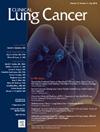3级细胞因子释放综合征导致肿瘤在两周内消退和萎陷肺重开后再用塔拉他单抗:一例报告。
IF 3.3
3区 医学
Q2 ONCOLOGY
引用次数: 0
摘要
•塔拉他单抗的肿瘤消退起始时间可短至2周。•在3级CRS后使用标准预用药重新使用塔拉他单抗是安全的。•Tarlatamab联合IMRT提供安全高效的中枢神经系统控制。•由肿瘤负荷引起的肺萎陷可能在塔拉他单抗单药治疗下再次扩大。本文章由计算机程序翻译,如有差异,请以英文原文为准。
Tarlatamab Rechallenge After Grade 3 Cytokine Release Syndrome Leading to Tumor Regression in Two Weeks and Reopening of a Collapsed Lung: A Case Report
- •Tarlatamab's onset of tumor regression can be as short as 2 weeks.
- •Rechallenging tarlatamab after grade 3 CRS with standard premedication is safe.
- •Tarlatamab combined with IMRT offers safe and highly effective CNS control.
- •A collapsed lung from tumor burden may re-expand with tarlatamab monotherapy.
求助全文
通过发布文献求助,成功后即可免费获取论文全文。
去求助
来源期刊

Clinical lung cancer
医学-肿瘤学
CiteScore
7.00
自引率
2.80%
发文量
159
审稿时长
24 days
期刊介绍:
Clinical Lung Cancer is a peer-reviewed bimonthly journal that publishes original articles describing various aspects of clinical and translational research of lung cancer. Clinical Lung Cancer is devoted to articles on detection, diagnosis, prevention, and treatment of lung cancer. The main emphasis is on recent scientific developments in all areas related to lung cancer. Specific areas of interest include clinical research and mechanistic approaches; drug sensitivity and resistance; gene and antisense therapy; pathology, markers, and prognostic indicators; chemoprevention strategies; multimodality therapy; and integration of various approaches.
 求助内容:
求助内容: 应助结果提醒方式:
应助结果提醒方式:


